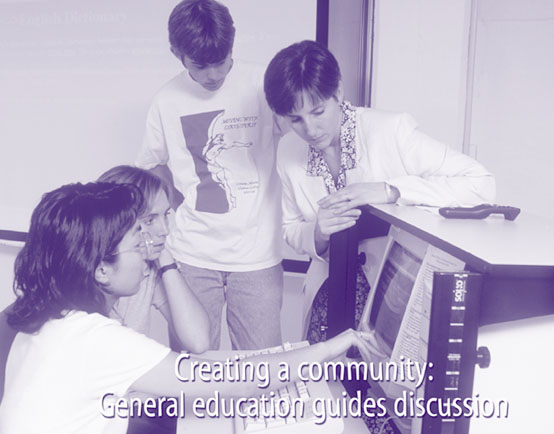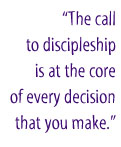
By Ryan Miller with Beth
Martin Birky ’83, associate professor of English
If the effort needed to explore how science and religion connect is as large
as the universe, and the attempts are older than the study of liberal arts,
can any one campus fully embrace it?
 From
an examination of the ethical questions behind the development of the atom bomb
to a look at medicine and faith healing, Goshen College professors are tackling
this year’s general education theme of “Science and Religion.”
From
an examination of the ethical questions behind the development of the atom bomb
to a look at medicine and faith healing, Goshen College professors are tackling
this year’s general education theme of “Science and Religion.”
Beth Martin Birky ’83, associate professor
of English, directs the general education program. A community theme was first
established in 1999-2000 with “Encountering the Millennium.” According
to its mission statement, the college’s general education curriculum is
“an instrument, or strategy, or method whereby the salient features of
the liberal arts philosophy of higher education are made available to our students.”
Birky simplifies that message.
“We want students to make connections
– not just learn science and learn about, say, art, but find where science
and art are interconnected,” she said. “Showing students with books,
classes, different speakers, that any single academic topic is part of a broader
network of understanding and meaning. That’s what a liberal arts education
is all about.”
Some professors have incorporated the theme
into their classes in interesting ways:
- Professor of Sociology Tom Meyers challenged his Principles
of Sociology students to interview 10 people to determine their views on the
source of “power” in medicine and science, the existence of miracles
versus scientific innovation and if spiritual matters can be explained in
scientific terms.
- Professor of Physics Carl Helrich’s The Physical
World class applied Kurt Vonnegut’s Cat’s Cradle to the making
of the atomic bomb, examining the ramifications of scientific advancement
on the modern world.
- Professor of English Ervin Beck’s colloquium
class read Cat’s Cradle and did group projects, one of which was
a short computer video on the ending of the book. See: www.daytheworldended.homepage.com/
icenine.html
- Associate Professor of Art John Blosser asked painting
students to create artwork embracing science and religious themes. (Some of
that artwork illustrates this issue of the Bulletin, see “About
this issue.”)
- Associate Professor of English Ann Hostetler hosted
a colloquium class at her home to discuss Brother Guy Consolmagno’s Brother
Astronomer.
- Assistant Professor of Philosophy Darrin Belousek
taught two related courses on the topic: Science and Moral Responsibility
and Philosophy of Religion.
- Bible, religion and philosophy chair Jo-Ann Brant’s
colloquium class examined biblical and scientific views on creation and her
Hebrew Prophets class looked at how an understanding of ancient science can
unlock biblical metaphors.
“There is a certain excitement in engaging
a topic from different angles. You can take one thing and learn about it from
a scientific perspective, a historical perspective, literary, artistic, anything.
The list could go on,” Birky said. “When you come at something from
an interdisciplinary perspective, it renews the bonding we’ve set up between
all the disciplines.”
The science and religion theme is not limited
to the classroom. Birky said several students have come to her amazed at how
their entire class schedule seems to weave in familiar themes over the course
of a term.
“We often get zeroed in on general education
as requirements, not general education as the building blocks of a liberal arts
education. Entering into the (science and religion) conversation means going
to chapels, reading books, just opening your ears,” Birky said.
Outside the classroom, campus conversations
about the intersection of science and religion began with faculty presentations
and workshops at an August 2000 faculty retreat. Last fall, guest speaker Consolmagno
and Helrich broached the subject in convocations and chapels. Lectures by Jitse
van der Meer, director of the Pascal Centre for Advanced Studies in Faith and
Science, and Nancey Murphy, professor of Christian philosophy at Fuller Theological
Seminary, highlighted spring conferences.
Students also watched the movie version of
Carl Sagan’s “Contact”; Birky said even mass media can help connect
book learning to the real world.
“We hope that focusing on an idea on
campus provides a new context for viewing events in broader society or the world,”
Birky said.
Birky quoted Edith Hamilton, best known for
work in mythology, when discussing the importance of learning for its own sake:
“It has always seemed too strange to me that in our endless discussions
about education, so little stress is ever laid on the pleasure of becoming an
educated person, the enormous interest it adds to life. To be able to be caught
up into the world of thought – that is to be educated.”
Students are not the only members of the campus
community challenged with seeking connections. Faculty members responded to
the general education theme at an August faculty retreat by asking their own
questions, including:
- Where does Scripture and reason (our observations
and experience) fit together?
- Are both science and religion, as they have developed
in the West, been forces of oppression in the colonized world?
- Religion and science both include faith systems. How
do we uncover the faith elements in science?
- How do we know that what we perceive in reality as
the work of God or the Holy Spirit is precisely that, given that
- God is not measurable by scientific means?
- How do scientists understand the “fallenness”
of creation?
- Are we searching for the truth or troubles?
- How can we be critical thinkers and also people of
faith?
- Is true collaboration possible between science and
religion? One is totally based on faith and the other on facts.
- How do I help students realize that they can study
and “believe in” evolutionary theory and yet be Christian?
- How do Christian scientists show through their discipline
that God is love? Surely the crux is the nature of human beings, which scientists
can and cannot explain or describe.
- How can we foster communities as people of diverse
faith and scientists who discuss before they produce technologies we do not
want?
- How can we help students accept that it is OK to live
in the questions, the mystery?
- How do we work through difficult questions such as,
“Unless we have the intellectual capacity of God, we cannot understand
God, either through science or philosophy. Why expend our energy to answer
the unanswerable?”
- Is truth absolute? Why can’t there be two “truths”
on the same issue?
- Are there areas into which scientists should not tread?
Similarly, in the arts or other studies, are there types of expression inappropriate
for Christians?
The campus will keep a religion focus during
the 2001-2002 school year with a community theme of “Vocational Emphasis
in Religion/Faith.” Beyond an examination of career planning, the general
education theme will parallel the college’s Cultivating Authentic Leaders
for Life initiatives made possible by a $2 million grant from Lilly Endowment
Inc. The CALL program intentionally focuses on helping high school- and college-age
youths examine and embrace invitations from God into church work and consider
how any career can be the Christian vocation to which God has called us.
“The call to discipleship is at the core of every decision that you make,”
Birky said.
Books for the 2001-2002 community theme will
include Parker J. Palmer’s Let Your Life Speak and Common Fire
by Laurent A. Parks Daloz, Cheryl H. Keen, James P. Keen and Sharon Daloz Parks.
Additional texts, films, and activities will provide opportunity for students,
faculty and staff to engage in the vocation conversation.
Return to April Bulletin
contents
Science and simplicity by
President Shirley H. Showalter
Traces of God’s handiwork in the universe
by Rachel Lapp
Measurements
of God: The search for truth and beauty by Carl Helrich
Science and spirit, hand
in hand by Debra Brubaker ’79
The best of times, the worst
of times by Owen Gingerich ’51
Marrying science and religion,
in classroom and home interview with Elizabeth (Miller) ’51 and Marlin
Jeschke
Return to Goshen College home page

 From
an examination of the ethical questions behind the development of the atom bomb
to a look at medicine and faith healing, Goshen College professors are tackling
this year’s general education theme of “Science and Religion.”
From
an examination of the ethical questions behind the development of the atom bomb
to a look at medicine and faith healing, Goshen College professors are tackling
this year’s general education theme of “Science and Religion.”